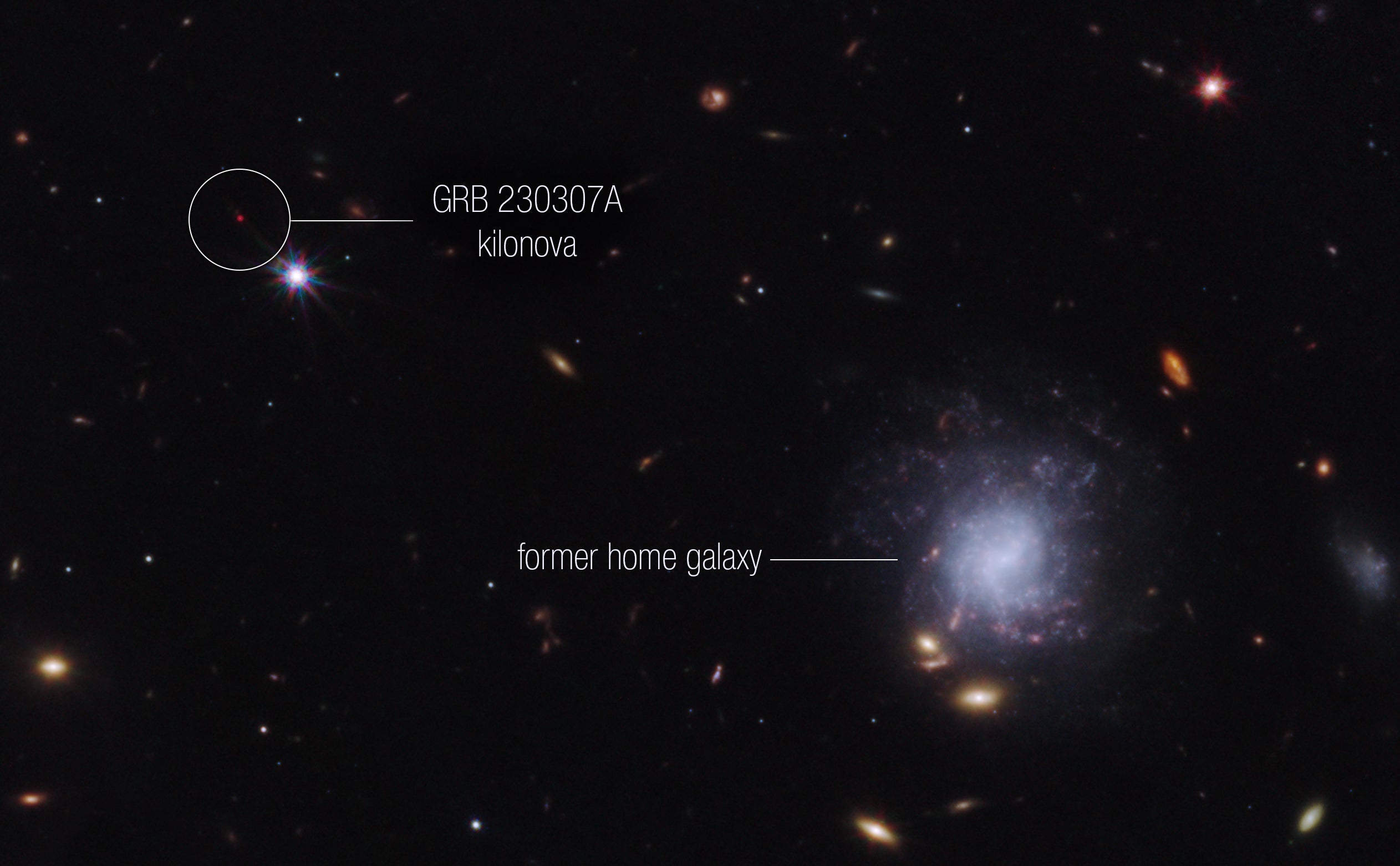
In March of this year, astronomers detected a brilliant burst of gamma rays more than a million times more luminous than our entire galaxy. It was the second brightest gamma-ray burst (GRB) ever detected and lasted some 200 seconds.
A study published today in Nature reports that this object was a collision of neutron stars one million light-years distant. What’s more, thanks to the James Webb Space Telescope (JWST), astronomers were able to see that the blast also served as a cosmic chemical factory, forging some of the rarest chemicals found on Earth.
“The most robust evidence that the merger of two neutron stars caused this burst comes from its kilonova,” says lead author Andrew Levan of Radboud University in the Netherlands, referring to the optical and infrared light coming from the uber-sized explosion.
The stunning JWST photograph published with today’s paper shows a kilonova hovering in space some 120,000 light years from a neighboring spiral galaxy. The pair of neutron stars that generated the kilonova were apparently ejected from that galaxy as a binary system, locked in a death spiral.
JWST’s exceptionally sensitive infrared instruments made all the difference to the study’s success, says Levan. “We have seen a handful of these before,” he notes, including a kilonova seen in 2017 that was also the first to be detected via its gravitational waves. “We didn’t have JWST back then, but now we have the ability to probe much redder wavelengths. That is just what you need if you want to understand kilonovae.”
JWST and bursts of discovery
Science has come a long way since GRBs were first discovered over half a century ago. At that time, the United States had launched gamma-ray detectors into space to monitor nuclear testing by the Soviet Union. When these satellites detected a sudden flash of gamma radiation far above Earth in 1967, the signal was so unlike a nuclear weapon that scientists at Los Alamos National Laboratory filed it away for later review. Dozens more were spotted in ensuing years, but the mystery surrounding these events prevailed until the late 1990s when ground and space-based observatories began linking strong X-ray signals with supernovae in distant galaxies.
Today, GRBs are discovered weekly. Astronomers think that most of them are caused by the explosions of massive stars at the end of their lives. Kilonovae represent a subset of GRBs, caused by collisions of neutron stars — the incredibly dense remains of stars that were massive enough to perish in a supernova, but not massive enough to collapse black holes.
The brightest ever long-duration GRB was detected in October 2022. Nicknamed BOAT — the Brightest Of All Time — it blinded most space-based gamma-ray observatories with a peak lasting several minutes.
While BOAT was blinding, this more recent kilonova — dubbed GRB 230307A for its year, month and day of discovery — provided strikingly clear evidence of individual heavy metals as well as compelling clues to its neutron star origins.
By analyzing the radioactive glow in the aftermath of the GRB’s relatively long explosion, Levan and his colleagues were able to spot heavy elements such as tellurium as well as rare, heavy transitional metals known as lanthanides. According to Levan, the creation of one element implies the likely creation of related elements, some of which may have been critical to the earliest life in the universe and the survival of life on Earth.
Today’s paper not only sheds light on how some of the universe’s heaviest elements are created, but spotlights the remarkable advances made possible by the world’s most powerful infrared telescope in conjunction with older space observatories, like NASA’s Fermi Gamma-ray Space Telescope and Neil Gehrels Swift Observatory. Fermi first detected the GRB on March 7, 2023. Follow-up observations in visible wavelengths with Hubble 30 days later saw nothing. But JWST’s infrared eye was able to clearly detect the glowing aftermath.
In addition, because Fermi cannot provide accurate locations, the GRB was pinpointed by triangulation, using an interplanetary fleet of spacecraft with gamma-ray detectors. They include NASA’s Mars Odyssey, launched in 2001 and currently orbiting the Red Planet, as well as the European Space Agency’s BepiColombo, currently on its way to Mercury.
GRB 230307A demonstrates that neutron star mergers can not only generate blasts lasting much longer than a few fleeting seconds — once assumed rare — but also that such phenomena are definitively linked with the production of some of the universe’s rarest and heaviest elements.
“It’s been a long mystery how the heaviest elements in the periodic table are formed,” says Levan. “With these observations, we are able to distinguish where some of the heaviest elements in nature form in the universe.”









